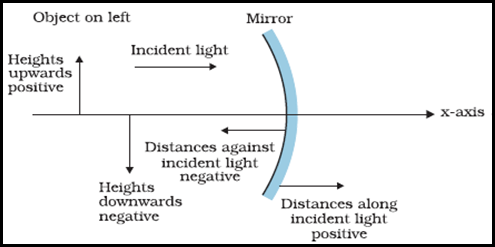Example
Kaleidoscope

Kaleidoscope is used to obtain a beautiful pattern of colours. Its principle is based on the multiple image formation by plane mirrors inclined at an angle to each other. It is formed by building a prism with three sides of mirrors. At one end, allow a ray of light to enter with the help of a cardboard piece with a hole. At the other end, place a few coloured particles(like bangles) over a glass plate.
Definition
Construction and Importance of periscope

Construction of Periscope.
A periscope works on the principle of reflection of light from one plane mirror placed at an angle() parallel to other plane mirror. Diagram shows the position of mirrors and light rays. In the figure and are the positions of mirror at an angle of .
Importance of periscope : Periscope is used by the submariners to view the objects at the surface of water.
A periscope works on the principle of reflection of light from one plane mirror placed at an angle() parallel to other plane mirror. Diagram shows the position of mirrors and light rays. In the figure and are the positions of mirror at an angle of .
Importance of periscope : Periscope is used by the submariners to view the objects at the surface of water.
Example
Periscope

Periscopes are used in order to see the objects that are not in direct line of sight. Its working is based on the laws of reflection. It consists of a set of parallel plane mirrors as shown in the diagram.
Definition
Convergence and divergence of mirrors

If reflected rays converge to a single point after reflection, then this is called as converging behaviour of the mirror . This is observed when a real image is formed. These can be used in applications where all intensity of light is to be focused at a point.
If reflected rays appear to diverge from a single point, then this is called as diverging behaviour of the mirror . This is observed when a virtual image is formed. These can be used in applications where the intensity of light is to be spread over the required region.
If reflected rays appear to diverge from a single point, then this is called as diverging behaviour of the mirror . This is observed when a virtual image is formed. These can be used in applications where the intensity of light is to be spread over the required region.
Definition
Sign convention

Sign convention is a set of rules to set signs for image distance, object distance, focal length, etc for mathematical analysis of image formation. According to it:
- Object is always placed to the left of mirror
- All distances are measured from the pole of the mirror.
- Distances measured in the direction of the incident ray are positive and the distances measured in the direction opposite to that of the incident rays are negative.
- Distances measured along y-axis above the principal axis are positive and that measured along y-axis below the principal axis are negative.
Result
Relationship between focal length, image distance and object distance for spherical mirrors

The figure shows an object AB at a distance u from the pole of a concave mirror. The image is formed at a distance v from the mirror. The position of the image is obtained by drawing a ray diagram.
Consider the and
(vertically opposite angles)
(right angles)
(third angle will also become equal)
and are similar
Similarly and are similar
But
If D is very close to P then EF = PF
But
Using sign convention,
So we can equation (3) as :
(R = 2f)
Dividing throughout by uvf, we will get :
This is the required equation.
Consider the and
(vertically opposite angles)
(right angles)
(third angle will also become equal)
and are similar
Similarly and are similar
But
If D is very close to P then EF = PF
But
Using sign convention,
So we can equation (3) as :
(R = 2f)
Dividing throughout by uvf, we will get :
This is the required equation.
Example
Calculate magnification of concave mirror
Problem:
The image of an object placed in front of a concave mirror of focal length 12 cm is formed at a point which is 10 cm more distant from the mirror than the object. The magnification of the image is:
Solution: We have:
Given: and
We have magnification,
The image of an object placed in front of a concave mirror of focal length 12 cm is formed at a point which is 10 cm more distant from the mirror than the object. The magnification of the image is:
Solution: We have:
Given: and
We have magnification,
Example
Calculate magnification of convex mirror
Problem:
An object is placed at a distance 2 f from the pole of a convex mirror of focal length f . The linear magnification is:
Solution:
(M is positive for convex mirror)
An object is placed at a distance 2 f from the pole of a convex mirror of focal length f . The linear magnification is:
Solution:
Here,
?
?
Now,
(M is positive for convex mirror)
| BookMarks |
Page 12 Page 13 Page 14 Page 15 Page 16 Page 17 Page 18 Page 19 Page 20 Page 21
Page 22 Page 23 Page 24
0 Comments
Post a Comment